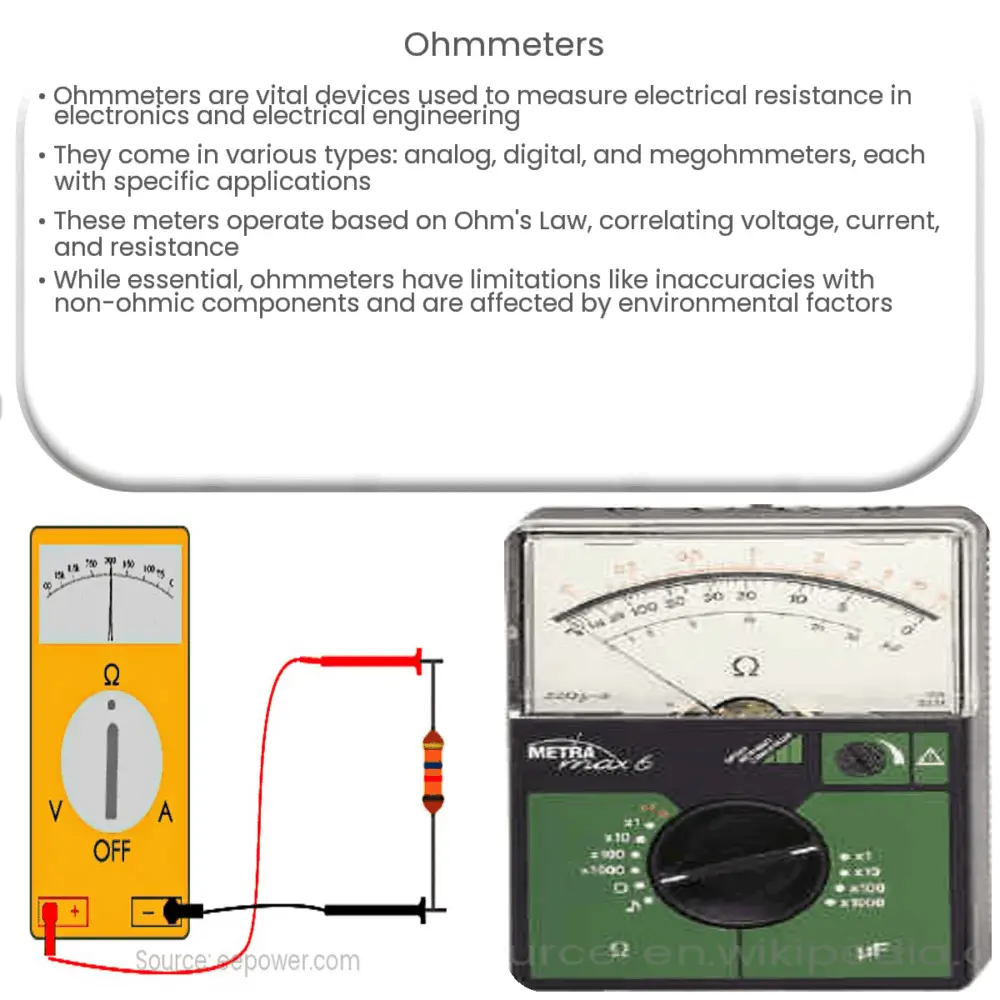Explore the world of Ohmmeters: their types, working principles, applications, and how to use them safely and effectively.

Introduction to Ohmmeters
Electricity plays a pivotal role in modern life. To ensure its safe and efficient usage, various devices have been designed to measure different electrical parameters. One such important device is the Ohmmeter, primarily used to measure electrical resistance.
Named after the unit of electrical resistance, the Ohm (Ω), Ohmmeters are essential tools in the field of electronics and electrical engineering. They help in diagnosing and fixing problems in electrical circuits and devices by providing valuable insights about the resistance within a circuit.
Types of Ohmmeters
There are several types of ohmmeters, each with its specific use case, including analog ohmmeters, digital ohmmeters, and megohmmeters.
- Analog Ohmmeters: These are traditional ohmmeters that employ a needle to display readings on a scale. The needle’s movement is proportional to the current flowing through the coil, which is inversely related to the resistance.
- Digital Ohmmeters: These are more modern and provide a digital readout of resistance values, offering more precise readings than their analog counterparts.
- Megohmmeters: Also known as insulation testers, these are used for measuring high resistance values, often in the mega-ohm or giga-ohm range.
Working Principle of Ohmmeters
Ohmmeters operate on the fundamental principle of Ohm’s Law, which states that the current passing through a conductor between two points is directly proportional to the voltage across the two points and inversely proportional to their resistance. Mathematically, it is represented as I = V/R, where I is the current, V is the voltage, and R is the resistance.
Ohmmeters have an internal battery that provides a known voltage to the circuit. By measuring the current that flows through the circuit when this known voltage is applied, the ohmmeter can calculate the resistance using Ohm’s Law.
Uses of Ohmmeters
Ohmmeters have a wide range of applications in both industrial and residential settings. They are frequently used by electricians and engineers to test and troubleshoot electrical circuits and devices. For instance, they can be used to verify the continuity of wires and cables, detect short circuits, or determine the value of an unknown resistor. In addition, ohmmeters are used in manufacturing industries to test the quality and safety of electrical products.
How to Use an Ohmmeter
Using an ohmmeter is relatively straightforward. The first step involves setting the device to the resistance measurement mode, typically indicated by the Greek letter Omega (Ω). Then, the device’s probes are connected to the circuit or component whose resistance is to be measured.
It’s important to ensure that the circuit or component being tested is not powered during the measurement as this could potentially damage the ohmmeter. Additionally, if measuring a component in a larger circuit, it should be isolated to prevent other circuit elements from affecting the measurement.
Precautions While Using Ohmmeters
While ohmmeters are useful and typically easy to use, there are certain precautions to be observed. As previously mentioned, the circuit or device to be measured should not be powered. Additionally, the device should be handled carefully to avoid any damage. Furthermore, it’s crucial to start with the highest range setting and then gradually decrease to avoid damaging sensitive components in the device being tested.
Limitations of Ohmmeters
Despite their utility, ohmmeters have certain limitations. For instance, they may not provide accurate measurements for components that exhibit non-ohmic behavior, such as diodes and transistors. Also, for very high resistance values, the internal battery of the ohmmeter may not supply sufficient voltage for an accurate measurement. Lastly, environmental factors such as temperature can affect the accuracy of an ohmmeter’s readings.
Conclusion
In conclusion, ohmmeters are crucial devices in the world of electronics and electrical engineering. Their ability to measure electrical resistance makes them indispensable in diagnosing and fixing electrical issues, testing product quality, and even in scientific research. While they do have some limitations, understanding these and taking appropriate precautions can ensure their effective and safe use. Whether you’re a professional electrician, an electronics enthusiast, or a student, mastering the use of an ohmmeter is a valuable skill in the realm of electronics.

